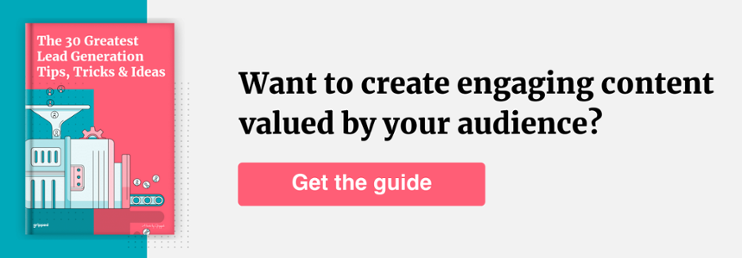Consumer habits are rapidly changing thanks to the lifestyle changes forced by the pandemic, coupled with drastic changes to the online advertising infrastructure have caused seismic shifts in the digital marketing landscape.
While this forced evolution holds a lot of opportunities, keeping up with the rapid pace of changing best practice comes with a cost in both time and money. Staying on top of new digital marketing tactics can be a challenge for a CMO (Chief Marketing Officer) especially one on a tight B2B marketing budget.
The good news is that there are still budget friendly but effective marketing options available and today we’ll be setting out four of the most productive CMO marketing solutions.
Solution #1: Content is key
At its most basic, content marketing involves creating and sharing materials that do not specifically promote a company but instead creates interest in the goods and services the company offers.
But content can also be used as a lead magnet. That is, access to desirable content might require the customer to input an email address or sign up to a newsletter. These contact details can be used later as part of a more direct marketing campaign.
For service based businesses, content marketing can be used to establish a brand as a thought leader or (SME) subject matter expert — speaking informatively about a subject demonstrates a businesses’ domain authority and integrity, which in turn can generate respect and trust in a brand.
Common content marketing materials include:
- ‘How to’ guide: These establish a company as an expert in a particular field and draw attention to the products used or the value of expert services.
- Expert tips: These are often used as lead magnets, requiring the potential customer to give up contact information in order to access expert advice that addresses a specific problem.
- Educational articles: These normally only contain minimal direct marketing tactics, but rather seek to establish a company as a subject matter expert on more advanced topics.
- Visual media: Video shorts, YouTube content, webinars, even Tik Tok clips represent viable forms of content that can be used to reach new audiences.
Content marketing is simple to set up, easy to distribute and cost effective. However, to get the best out of your content, you need an effective content marketing strategy.

The four step content marketing strategy
Taking this simple four step approach will help you produce and distribute the right content to the right audience:
- Position your brand: Before you start producing content, you need to spend some time clearly defining both your brand and the target audience you are aiming to reach. This allows you to build a consistent approach and brand voice across all your content.
- Define content value proposition: The key question when it comes to defining your content’s value proposition is “why is this valuable to the customer?”. Good quality customer and competitor research is vital at this stage as it helps to define what your target audience wants and what competitor content they are responding to.
- Utilise business cases: As with all marketing solutions, content marketing needs to have a tangible business outcome. It needs to drive your business forward. Creating a business case for your content will help to highlight the risks, costs, and potential ROI (return on investment).
- Align with your business strategy: To achieve best effect of any CMO marketing solutions, all oars need to be pulling in the same direction. Any content marketing strategy should be contributing to an overall business strategy. If it isn’t, then you’re just wasting time and money.
The great benefit of content marketing is that it generates a theoretically limitless amount of organic traffic and, once published, does that without the need for oversight or additional spending.
The major drawback is that creating effective content requires a certain level of expertise. The only thing worse than no content is bad content.
Solution #2: Invest in a digital presence
For most businesses, regardless of their bricks and mortar presence, their website will be the first point of contact between them and their customers. While nearly all businesses have a website, even in 2022, effective website design practices tend to be a low priority.
Pro tip: For more information on what exactly makes a B2B website effective, check out our blog — 12 Components to Implement a Successful SaaS Web Design (with examples)
Despite the fact that 33% of all online retail traffic is generated via mobile devices, many websites are not even mobile optimised.
In order to generate significant traffic, websites need to be designed with a specific flow in mind. While the exact detail of this flow will change depending on the business, the basic stages remain the same:
- Attract new people: Websites need to be visually appealing, logically laid out, easy to navigate and optimised for the widest possible range of browsing options.
- Nurture leads: Depending on the business, nurturing leads might mean providing the widest possible range of payment options, convincing visitors to reach out via phone chat or email, or gathering contact information via lead magnets.
- Convert contacts into customers: Even if the customer doesn’t choose the goods or services on offer during their visit, your website should be designed to capture contact details so that additional marketing efforts can be put in place to convert contacts into customers.
While putting in place an effective digital presence is vital to your CMO marketing plans, executing it properly normally requires in-house experts and can be both difficult and expensive if done wrong.
Solution #3: Get on social media
If you haven’t yet realised the value of social media marketing, then you’re already well behind the line.
Social media advertising is a way of reaching out to the estimated 3.6 billion potential customers on social media and is already used by 83% of marketers, who rank it as only slightly less effective than SEO (search engine optimisation) as a marketing tool.,
If you’re new to a social media marketing or if your current approach isn’t working, here are some steps you can take to put in place effective social media marketing plans:
- Choose your platforms: Not all social media platforms cater for the same audience. Depending on your brand, you aren’t going to get the same interaction on Facebook as you are on Tik Tok. Do your research first and find out which sites your target audience prefers and concentrate your efforts there.
- Follow the social media ‘Rule of Thirds’: When it comes to sharing content from other, as you should be, always follow the rule of thirds:
Top tip: For those of you who don’t know what the rule of thirds is (and we wouldn’t blame you if you didn’t), it goes as follows…
- ⅓ of your shared posts should be to convert readers, promote your business, and generate profits.
- ⅓ of your shared posts should be ideas from influencers and SMEs in your industry.
- ⅓ of your shared posts should be personal stories to help build your brand and connect with your audience.
- Be active and responsive: Don’t just post and run, interact with your target audience in real time and try to foster a genuine sense of community and interactivity.
- Be aware of competitors/other players and what they’re doing: There’s always something you can learn from your competitors and ignoring their efforts is just depriving yourself of access to potentially great ideas.
- Don’t cut and paste everywhere: What works on Facebook will not work on Pinterest. Reusing content is fine, but it has to be shaped to fit the specific platform you are posting on for best results.
Solution #4: Get third party help
If all of the above looks intimidating, burdensome, or just outside of your timeframe and skillset, there is another option. Get the experts in.
Marketing is one of those odd areas where people are often reluctant to use expert help despite the tangible material benefits it offers, so here are 10 good reasons you should outsource your marketing efforts:
- An outside perspective is an ideal way to get you out of a rut and provide innovative solutions to your problems.
- Your ideas are no longer constrained by existing resources and can be scaled quickly.
- Staff absence or vacation won’t impact your marketing.
- Outsourcing offers manpower and expertise without the overheads associated with hiring.
- B2B marketing agencies can provide expertise in marketing channels you might not have considered.
- Using outsourced marketing can help you concentrate on the overall strategy while they handle the day-to-day work.
- Professional marketing agencies use the best technologies and hire the finest experts, giving you access to both.
- The added resources and people-power offered by outsourcing can increase your overall efficiency.
- With an outside agency handling marketing, skilled staff can be moved onto other projects where their input is best used.
- Marketing agencies exist because they work. It’s that simple. Outsourcing generates results and gives companies a better ROI.
Setting up your own in-house marketing department might give you a little more direct control, but it’s no guarantee of success and comes with significant costs.
With outsourced marketing, you can verify the company you’re planning on using, get expert help on day one, incorporate their technology and expertise without upfront buying and hiring costs and see a great ROI without needing to hire, train, and onboard anyone.

Partner with Gripped to revitalise your marketing efforts
An expert and experienced digital marketing company with a proven track record of getting our customers tangible results, Gripped offers a range of outsourced services, including:
- Digital Marketing Strategy: Transform your digital sales and marketing
- B2B Inbound Marketing: Generate market presence build trust
- Lead Generation: Deliver more, better-qualified leads
- B2B SEO: Get found and increase traffic to your site
- Content Marketing: Create high-quality content that engages
- Paid Search And Social: Be visible, grow your audience, convert leads
- Martech & Marketing Automation: Create a tech stack that is delivers more
- Sales Enablement: Align sales and marketing, drive results
- Website Development: Get your new conversion-ready website
Outsourcing to Gripped is simply more cost effective and generates better results than recruiting in-house. Get your free growth audit to find out how Gripped can help you revitalize your marketing efforts!
